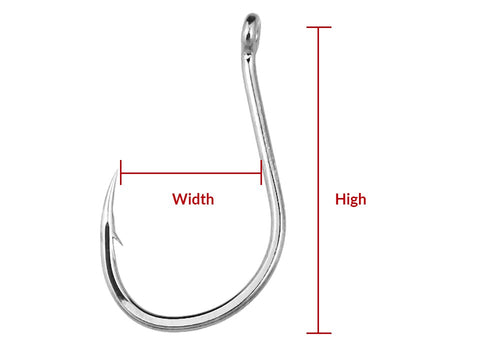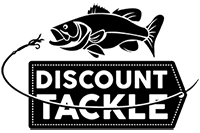
Fishing Hook Basics: Types, Sizes, & Uses
By Discount Tackle Staff
There is nothing better than being out on the water with your friends and family enjoying nature, laughing, talking, and fishing. And the experience can only be improved when you have everything you need for a fun day fishing; having all the right fishing baits and tackle is essential to making the most of your time on the water.
A fishing hook is perhaps one of the most crucial fishing tackle items after your fishing rod and reel. This means a good selection of fishing hook types and hook sizes can be essential to making your fishing trip memorable and productive.
In this blog post, we break down the four major categories of fishing hooks and explain the different sub-types that make up each category, the rigging techniques and baits they are most often used with, and the species they are used to target. Finally, we provide a short explanation of hook sizing and hook strength naming conventions.
Type & Uses of Fishing Hooks
Artificial & Soft Plastic Bait Hooks
As their name indicates, artificial and soft plastic hooks are used for artificial and soft plastic bait rigs using soft plastic jerkbaits, worms, swimbaits, creature baits and more. Some of the most popular styles include worm hooks, extra wide gap (EWG) hooks, flipping hooks, drop shot hooks, and weighted and unweighted swimbait hooks.
Gamakatsu Black EWG Offset Worm Hook
In conjunction with weights and sinkers, worm hooks and EWG hooks can be used for Texas and Carolina rigging soft plastics. Drop shot hooks' primary use is pretty self-explanatory: drop shot baits, but these hooks are often used for wacky and Neko rigging soft plastic worms and stickbaits, as well. That said, some tackle makers even make dedicated wacky and Neko hooks too. Swimbait hooks can be used with soft jerkbaits and paddle tail swimbaits.
Use of Artificial & Soft Plastic Bait Hooks
These hooks are ideal for freshwater fishing for species like largemouth bass, smallmouth bass, spotted bass, crappie/panfish, trout, pike, muskie, and walleye, as well as small inshore saltwater fishing species like redfish, sea trout, flounder, drum, and striped bass. Because of their rigging versatility, you can use them in rocks, weeds, and even timber.
Bait Hooks
Bait hooks are used for rigging live or cut bait such as live baitfish, strip baits, live nightcrawlers, fish eggs, and chunks of shrimp, crab, and other crustaceans. Popular styles of bait hooks include baitholder hooks, octopus hooks, J-hooks, circle hooks, and aberdeen hooks.
Eagle Claw 186AH Ringed Eye Baitholder Hook
Baitholder hooks have little barbs (sometimes called slices) along the shank of the hook that help keep chunks of cut bait on the hook. Octopus hooks get their name from their shape, which resembles an octopus tentacle. These hooks are used for a wide variety of fish species in both saltwater and freshwater and are often rigged with a live baitfish or egg clusters. J-hooks are somewhat similar to octopus hooks, except their shape more closely resembles the letter "J" (hence their name). These hooks are typically used for bait fishing for offshore saltwater species like tuna, sailfish, wahoo, and marlin.
Circle hooks can be used with almost any type of bait and are unique in that they don't require the angler to "set" the hook, but rather the hook sets itself in the corner of the fish's mouth as it tries to swim away with your bait. Circle hooks are also best for catch and release fishing because they are the least likely to mortally wound the fish when they're hooked.
Aberdeen hooks are very light and delicate and are almost exclusively used for fishing live minnows and other live baitfish to target crappie and other panfish like bluegill, sunfish, and bream.
Use of Bait Hooks
Bait hooks can be used in different casting, trolling, and jigging set-ups for freshwater species such as trout, salmon/steelhead, catfish, panfish, perch, and walleye, as well as virtually all saltwater fishing species.
Saltwater Hooks
Saltwater hooks, as their name implies, are intended to be used for saltwater fishing. Hooks that fall into this category are typically constructed with hard metal wire that is then molded into sharp and long points. Although you will find saltwater fishing hooks in many shapes and sizes, they are usually made of one of two materials: high-carbon steel or stainless steel. Saltwater hooks must also be made with corrosion-resistant finishes like tin to survive in corrosive saltwater environments.
Gamakatsu Heavy Duty Live Bait Hook
For our purposes, we define saltwater hooks as any hook suitable for use in saltwater, meaning there is some overlap with other categories. For example, a hook like Gamakatsu's Heavy Duty Live Bait Hook is classified as both a baithook and a saltwater hook because it used for bait fishing, but also robust enough to survive saltwater environments and big game species. Similarly, heavy-duty treble hooks like Mustad's 3565 DuraSteel O'Shaughnessy Treble Hook 2X Strong are both treble hooks and saltwater hooks because they have a treble hook design that is suitable for saltwater usage.
VMC 7237 InLine Single Hook 1X Coastal Black
That said, there are few styles of hooks that are, broadly speaking, only used for saltwater fishing. These include jigging assist hooks used on metal saltwater jigs and inline single hooks used on saltwater trolling and casting hard lures (aka plugs).
Use of Saltwater Hooks
Saltwater hooks are suitable for use for casting, jigging, and trolling with both artificial lures and real bait for all saltwater species. Thanks to their strength, certain types are also a good choice when targeting big game freshwater species like catfish, pike, muskie, and sturgeon.
Treble Hooks
Treble hooks are hooks with three points on them. They are most often used on hard baits and lures, but can also be found on some soft body swimbaits, live bait rigs, and even fished alone with dough baits for trout, panfish, and catfish.
Mustad D3551 Dough Bait Treble Hook
In addition to varying sizes and strengths, treble hooks also come in a wide variety of hook shank sizes and bends. For example, there are short shank trebles that have a shorter shank section between the eye of the hook and where the shank diverges into its three points. This shorter shank style is best fished on hard baits that will be retrieved near grass and vegetation because the hook points are closer to the body of the bait and do not snag as easily. When properly hooked up with, the shorter shank trebles also do a better job of keeping fish pinned and make it harder for them to use the hook shank for leverage to throw the hook.
Owner ST-36 Round Bend Treble Hook Black Chrome
Another popular treble hook style are round bend treble hooks. Just like their name implies, round bend treble hooks have a hook points parallel to the hook shank, which creates a perfectly round bend in the hook. The purpose of this design is to make it easier to hook fish that swipe at the lure instead of fully committing to striking it. There are a few other subtypes of treble hook designs, such EWG treble hooks and feather-dressed treble hooks, but for simplicity's sake we will end our discussion here.
Use of Treble Hooks
Treble hooks are used in both freshwater and saltwater fishing on casting and trolling lures, crankbaits, metal jigs/spoons, swimbaits, and a few other specialty, niche bait rigs. They generally are not good for use around heavy vegetation and weeds because they are highly prone to snagging.
Fishing Hook Sizes & Strengths
In addition to a wide range of shapes and designs, fishing hooks also come in many different sizes and wire gauge strengths. Different sizes and strengths are used for different species and bait presentations.
Fishing Hook Sizes
Fishing hook manufacturers make hooks in an incredibly wide range of sizes; everything from the tiniest treble hooks for trout and panfish all they way to massive circle hooks used for shark fishing.
The size of a fishing hook is based on both the width between the point and the shank of the hook as well as the overall length (or height) of the hook shank.

Fishing hook size naming conventions can be somewhat confusing. Generally speaking, mass produced fishing hook sizes range from 18 all the way up to 12/0 (pronounced "12-aught"), with size 18 being the smallest and 12/0 being the largest. For hook sizes between 1 and 18, the higher the number, the smaller the hook. In other words, a size 1 hook is much larger than a size 18 hook. For sizes 1/0 and above (there is no such thing as a size 0 hook), higher numbers equate to larger hooks, meaning a 12/0 is much bigger than a 1/0.
Fishing Hook Strengths
While its pretty obvious that fishing hooks are made in lots of different sizes to match different size fish, did you also know that hooks are also made from different wire gauges or thickness? Usually, they run from extremely thin wire to thicker gauge wire. For instance, fine wire, 1X strong heavy wire, 2X strong heavy wire, 3X strong heavy wire, and 4X strong heavy wire, and higher.
Stronger hooks are used for big game species like catfish, tuna, marlin, and sturgeon, while lighter fine wire hooks are used on more delicate species like crappie, trout, and perch.
Final Thoughts
Fishing hooks come in a myriad of styles, sizes, and strengths and each has characteristics, benefits, and intended uses. A fishing hook is an important part of fishing and being familiar with the various parts, sizes, and types of fishing hooks will help you in choosing the perfect hooks for your next fishing trip.
So, the next time that you are on the water pondering what fishing hook to use do not fret. Follow our breakdown, and you will easily determine at the type of fishing hook that will help you put more fish in the net!








